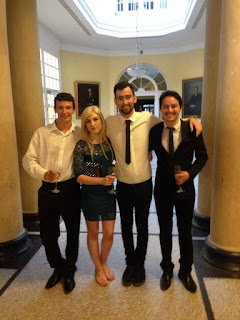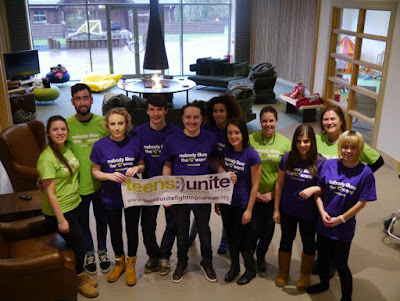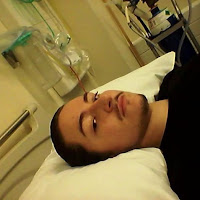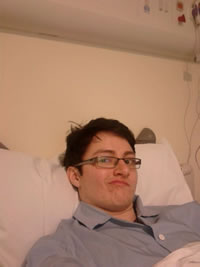Tuesday 6 September 2016
Wednesday 22 June 2016
Film Review: The Conjuring 2
Last Friday I went to see The Conjuring 2. I'm a massive horror fan, with supernatural horror being my favourite subgenre, and I loved The Conjuring, along with James Wan's other films, so this one was a must-see.
Both films are based on the case files of real-life paranormal investigators Ed and Lorraine Warren. The Conjuring opened with the Warrens involvement with the haunted doll, Annabelle, before moving to a completely unrelated case about the Perron family. Similarly, The Conjuring 2 opens with a view from one of the iconic quarter-circle windows of the Amityville house.
The most exciting thing I found about this prelude to the story was a scene where Lorraine spies a ghostly boy with glowing white eyes peering round a corner in the house. If you aren't as worryingly obsessed with horror as I am, you may not have realised that this shot was actually based on a real photo of an unexplained boy, which was taken in the abandoned Amityville house after the Lutz family famously fled the property.
 |
| Real image of a ghostly boy, taken in the Amityville house |
Whilst this probably went over many people's heads, it's a big fangirl moment for people with an interest in the paranormal.
Again, like The Conjuring, the film then takes its focus to a completely unrelated case of the Enfield poltergeist. Thankfully, we don't see any terrible attempts of English accents, which are all-too common in Hollywood, and in fact, the representation of English life is pretty accurate, from the weather (raining throughout) to the school uniforms and run-down council estates.
If you like jump scares, then you're in for a treat, because there are plenty. Also, if you're already familiar with the story of the Enfield poltergeist, this isn't a retelling of the same tale you've heard numerous times before, and still offers much to surprise you with.
Sadly, this means that the film isn't wholly based on the true story. Some of this has obviously been done for the cinematic effect (such as the crucifixes scene, and the slightly-cringeworthy CGI "Crooked Man") as well as satisfying the need to keep the film fresh and original for audiences. For sure, the Warren's involvement in the case has been exaggerated by a mile, as they were not the principal investigators for the case, and cannot be credited for stopping the hauntings. In fact, people who have lived in the house after the Hodgson family, claim that it is still haunted to this day (but that wouldn't make a climatic ending, would it?)
Having said that, the source materials have been used excellently; scenes from the case files are replicated well, including reports of levitation, the background of the poltergeist, the recorded interviews and the infamous "spoon bending" incident.
By far the scariest feature in the film, however, is the nun.
I'm pretty sure this character (who is in the same vein as Insidious' black-veiled old woman) is just a product of James Wan's imagination, and not from any real paranormal investigations from the Warrens, but that doesn't make her any less creepy.
The nun has a slow-moving, silent and unexplained presence to begin with, which makes her sinister and ominous, which is what I think I found so unnerving about her. She's used as a narrative device to string the story together, and she's undoubtably been thrown in to make the film ten times scarier... but it comes as no big surprise to hear that (similar to "Annabelle") the creators of The Conjuring 2 are intending to make a spinoff film, solely about the nun, which I'm guessing is the main reason of her feature in the film. (P.S. I will be first in the queue to see it.)
So, the verdict?
Whilst The Conjuring 2 is far from a documentation of the real Enfield haunting, it provides great entertainment to keep you on the edge (or jumping out of) your seat, which fans of the original will neither want to miss, nor be disappointed by. James Wan does not fail to deliver with his excellent talent to scare audiences, and manages to keep the famous story fresh, but enough of the true case present to send continual shivers down your spine.
*CLAP CLAP*
Pete
Thursday 26 May 2016
End Date Ball: Details!
So as I announced in my last vlog, I'm celebrating ending treatment by having a ball at The Duke Of Cornwall Hotel in Plymouth to raise money for CLIC Sargent. Here are some more details!
The Menu
The catering staff at The Duke of Cornwall have put together a great 3-course set menu for us, with coffees to finish. They are also happy to accommodate and adapt the menu for any dietary requirements, they just need to know up-front.
 |
| The Duke Of Cornwall Ballroom |
The catering staff at The Duke of Cornwall have put together a great 3-course set menu for us, with coffees to finish. They are also happy to accommodate and adapt the menu for any dietary requirements, they just need to know up-front.
Starter
Smoked chicken Caesar salad with garlic croutons and crispy bacon
(V) Tomato, roast pepper and aubergine soup with basil pesto
Main
Braised rump steak in stout with button mushrooms, onions and crispy bacon
(V) Butternut squash risotto with pine nuts, spinach,chives,watercress and black truffle oil
Dessert
Baked chocolate fudge brownie with chocolate, caramel, pecan sauce and Cornish clotted cream
Entertainment
I'm pleased to announce that we have the support of the amazing Scarlet Sirens burlesque group, who will be kicking off the evening by performing a routine for us. There will also be a disco after the meal, and perhaps some additional performers!
Dress Code
The dress code for the event is formal, with black tie being optional. This means it's a great opportunity for you to get dressed up! There will be a photographer there too, to catch photos of everybody looking their best!
How To Buy Tickets
The tickets are now all printed and ready for purchase! They are £30 each and can be bought on PayPal using my email: PeteYJerrett@Yahoo.com , or can be bought from myself or any of my family in person. If you are interested in buying a table, they can seat from 8 - 10.
I'd love to see you there to make this celebration a success and to raise as much money as we can!
Pete
Sunday 8 May 2016
Vlog: The Big Buzz
The hair is gone! My current fundraising total is £300, thanks to all of the generous people who sponsored me. If you'd still like to do so, you can here! And thanks to YouTube, you can see the whole thing below, in glorious technicolour.
I'm really enjoying my new buzz cut at the moment, and very excited to be working on my ball which I will be posting more about soon. Get in touch if you'd like to hear more details or buy tickets!
Pete
Tuesday 26 April 2016
Maintenance: the Good, the Bad & the Ugly
I'm currently on my final, longest, and least aggressive phase of chemotherapy treatment for ALL, which is called maintenance.
What Is It?
I started maintenance treatment in January 2014. For boys, this phase lasts 2 years and 7 months, and for girls it lasts 1 year and 7 months.
Because I'm on a clinical trial, my treatment isn't the same as patients who were randomised to other experimental conditions. For me, maintenance treatment means the following:
- Oral chemotherapy every evening
- Additional oral chemotherapy once a week
- IV infusion of chemotherapy once a month
- 5-day block of steroids every month
- Intrathecal chemotherapy every 12 weeks
However, some people on the trial get randomised to not receiving the latter three.
The purpose of maintenance treatment is mostly preventative care; most of the leukaemia cells are killed in the intensive stages of treatment, and this is mostly to make sure they stay that way.
The Good
Maintenance treatment is a lot easier on the body than the intensive stages. People will be put on different doses of treatment but in general, all of the side effects of the chemo slowly get a bit better and more manageable. Your hair grows back and the sickness and nausea aren't as incessant.
As well as the meds getting more manageable, so are the hospital visits. I still need to go in for chemo, clinic and blood tests (fun fact: Google Maps has automatically marked the hospital as my "place of work") but this has gone from being nearly ever day to about every other week, which means hospital visits aren't running my life as much any more.
Both of these mean that you can do more. This differs from person to person, depending on their situation, but I myself have been able to take on some voluntary work which I wouldn't have been able to do beforehand. Because my immune system is a bit stronger, I'm able to go on short breaks away and more social events, as well as a lot more freedom with what I can eat!
A lot of the opportunities offered by cancer charities aren't suitable for patients on the intensive phases of ALL treatment, but maintenance gives you that bit more flexibility to take part in them. For example, you can see some of the stuff I've been up to with Teens Unite here.
The Bad & The Ugly
One of the common complaints I hear amongst my ALL friends is that "people assume you're okay now, but you're not".
Basically, maintenance makes me feel like I've got a constant hangover. I can have the best night's sleep ever and still wake up feeling tired and drained of energy. This is something I have got a little accustomed to over time, but it still takes its toll. I often find I can't join in with things which are early in the morning or late in the evening, as I will be too fatigued, which goes against the grain of a 21-year-old's ideal social life.
Most of the side effects are pretty manageable, and nothing I should complain about, but they are all still there. I spoke previously about how my hair is thin and falls out easily, and nausea and vomiting will affect me about once a month. Because my immune system is still pretty poor, I'm more susceptible to things like colds and infections, which hit me harder than they would a normal person. As I said, they're nothing I should complain about, but I still have unpredictable "bad days", which (in conjunction with day-long hospital visits) means that at the moment I couldn't even consider getting a part-time job.
It was at the maintenance stage that I realised the longer-term implications of cancer. As many of you know, my steroids had to be stopped because of avascular necrosis in my ankles. This means that, in the past year, I have had to give up running and my gym membership: two things which I loved doing and really helped with my mental and physical wellbeing. (I've been struggling to find forms of exercise which I'm physically able to do, and am currently trying to give swimming a try, so fingers crossed!)
The most frustrating thing I've found with maintenance treatment is that I try to fit in to normal life again - the life that my school friends and other people my age are living - and find I'm not able to, or I don't fit in any more because I've been sat in hospital not doing anything for a few years whilst everybody else has been moving forward, which is unbelievably disheartening.
Many patients, myself being one of them, enter maintenance and "try to run before they can walk". I've found this applies to most aspects of life: social, fitness, romance, work, etc. - like you're running through mud and getting nowhere fast.
Finally...
Despite the good, the bad and the ugly, maintenance is something which I try my best to just get on with, and haven't really spoken (or moaned) about much until now. Of course, I have much to be thankful for, I guess I just wanted to put across the whole picture and both sides of the stage which I am at right now.
As always, a reminder that everybody's experience of cancer is different, and I have seen so many different experiences of people going through maintenance. This is just about my own experiences!
Feel free to add a comment or question below, or fill out the contact form!
Thanks for reading
Pete
Wednesday 20 April 2016
Before The Buzz
I can't believe how quickly my fundraising target for my headshave was smashed! A big thank you to everybody for your kind and generous donations.
As I mentioned in my last post, I have brought plans to shave my head for charity forward, and I set myself the fundraising target of £170, which would cover the cost of the initial care grant given out by CLIC Sargent at diagnosis. Within a day, this target was smashed, and currently stands at £260! (See JustGiving page here).
£230 could fund for a family to stay in a CLIC Sargent Home From Home for a week, as my family did (but I'll probably post more about that later) - so this is an amazing amount! I wanted to write this post to give some details, before the buzz...
I originally wanted this to coincide with another fundraiser which I am working on and will be announcing soon, but I wanted to move it forward, before my hair is too thin to donate!
This is why I didn't set myself a really high fundraising target for my Big Buzz - I didn't want to be haggling people for sponsorship just before asking them to support my next fundraiser - which is something I'd really like a lot of people to get involved in!
I haven't made plans for the actual headshave - which is in just under two weeks time - but rest assured, I will be posting a video of it happening, and lots of photos, so watch this space.
As I said before, I will be donating my cut hair to Little Princess Trust. Due to the chemo, dye and everything else I have subjected my poor hair to, I'm not sure that it will be good enough quality to be made into a real hair wig, but it's certainly long enough and I can but try!
If anybody would like to donate to help smash my target even further, here is my JustGiving page: justgiving.com/petebigbuzz
Thanks for reading!
Pete
Monday 4 April 2016
Hair
I wasn't planning on doing this so early, but my chemo dosage has just been increased again, so here we go!
 |
| My hair - December 2015 |
For the past 18 months or so, I have been growing out my hair, and now have a man-bun which is several inches long. There are a couple of reasons for this, the first, but least prominent, being me experimenting hairstyles as I have been since the beginning of secondary school. More importantly, due to still being on chemotherapy, my hair is very thin, so I wanted to grow it long to create the illusion of thickness (you could see my scalp through my hair when it was shorter).
However, the most important reason is that I have been planning on shaving it off all along.
On the 3rd May, I will be taking on The Big Buzz for CLIC Sargent and shaving my head back to the wood to raise money for children and young people with cancer, and their families.
 |
| My LPT wig - October 2013 |
The reason for the growth is that my hair is now over 7 inches long, I can donate my cut hair to Little Princess Trust, to be made in to a wig for a young person who has lost their hair. LPT provided me with an amazing acrylic wig whilst I was going through the intensive stage of my treatment, so it would be great to give something back to them, and maybe help another young person... provided my hair is good enough quality!
The dosage of my chemo tablets has just been increased again, as per the protocol. This isn't a problem for me, but every time the dosage is increased, my hair weakens, gets thinner and molts easier, so I've brought the date of my Big Buzz forward.
My fundraising goal for this challenge is £170, which would fund an initial CLIC Sargent grant, which is given to a young person within the first 72 hours of a cancer diagnosis. This is to help with the initial additional incurred costs, such as travel and accommodation, and was greatly helpful to myself and my family.
I have set up a JustGiving page if anybody would like to sponsor me - if 100 people sponsor me £1.70, I will have hit my target! https://www.justgiving.com/petebigbuzz
Thanks for reading!
Pete
Tuesday 1 March 2016
Charity Tuesday: Teens Unite
I aim to make Charity Tuesdays a recurring feature on my blog, to expose some of the charities I have come into contact with and what they do, to raise awareness and support. The first charity I have chosen to feature is Teens Unite Fighting Cancer.
Who They Are
Teens Unite Fighting Cancer is a London-based charity which was founded in 2007 to provide ongoing support for teens and young people who are facing cancer and other life-limiting illnesses.
What They Do
Much of Teens Unite's work is dedicated to providing social experiences for 13-24 year-olds with life-limiting illnesses such as cancer, to help combat feelings of isolation and to facilitate invaluable peer support. They often run events, activities and workshops to benefit these young people. These include fun days out, such as sports matches, concerts, pizza making and go-karting; beauty and pampering workshops to help rebuild lost confidence; and more formal experiences to help teens gain practical skills for their lives ahead.
They also arrange social events for the parents and guardians of these young people, which can be hugely beneficial for them, too.
Teens Unite have a Respite Home in Broxbourne, where many of their activities and workshops are held, and where teens are welcome to stay overnight for a relaxing break from the harrowing medical world.
How They've Helped
 |
| "Team Bristol" at Teens Unite formal meal 2014 |
I was introduced to Teens Unite by my social worker who used to work in London. She encouraged a group of us who were treated in Bristol to take part in an Activity Stay at Mill Hill. This was a really exciting week, involving Go Ape, an art workshop, a formal dinner and a sports workshop hosted by Olympic athletes. There were loads of other young people there from around the country, so it was really good to talk to them and share stories and experiences, as well as having the chance to form a close bond with the group we travelled from Bristol with.
Due to our circumstances, many of us (including myself) wouldn't have been able to travel to go on a summer holiday like the rest of our peers, however this opportunity gave us something to look forward to, and was a refreshing break from the norm. Because many of us are also not at work or university, you'd be surprised how rare it is for people like myself to be able to hang around with people in the same age group - to socialise and feel like a normal young person - so opportunities like these are amazing.
Because we had such a great time, we returned for the Activity Stay the following year, making some more great memories. We also travelled up for the 2014 Christmas party, which involved a lot of bowling and pizza, as well as some debatable pictures in the photo booth...
Why You Should Support Them
Teens Unite are a great charity with so much passion and commitment to their cause, which is demonstrated by even the CEOs engaging with the teens and working on the front line to ensure that the charity's endeavours are being accomplished to the full, something which is rare to see, but remarkably humbling, This makes the teens feel valued, and creates a warm and homely atmosphere, as well as giving the charity some real character.
To say the least, Teens Unite is rapidly developing, with much potential. During the short time since its establishment, the charity has grown incredibly, and is sure to help yet more young people and to get even bigger and better with time and the support of others.
Last year, I had the pleasure of travelling to Ireland with Teens Unite, to visit Daisy Lodge, a luxury, purpose-built respite home for young people with cancer and their carers. Teens Unite have since launched a campaign, with the hope of creating a similar home in England, for its teens to be able to enjoy for short breaks away.
 |
| A group of us at Daisy Lodge in Ireland - 2015 |
Teens Unite Fighting Cancer is registered charity number 1118361, you can find out more about them, what they do, and how you can get involved with them here.
Pete
Wednesday 17 February 2016
Spinal Tap
I've just had what I estimate to be my 27th spinal tap.
Lumbar puncture, IT, spinal tap, intrathecal... a rose by any other name would smell as shit.
For those of you who don't know, these play a big role in my treatment, as unpleasant as they are.
What It Involves
 The procedure involves sitting on the edge of a bed and bending forward, so that the lumbar vertebrae of my spine open up. A doctor then prods and pokes around to find a good spot, then injects local anaesthetic into either side, to numb the flesh. Once numbed, the doctor inserts a needle into the gap between my vertebrae to puncture the spinal cord and collect spinal fluid.
The procedure involves sitting on the edge of a bed and bending forward, so that the lumbar vertebrae of my spine open up. A doctor then prods and pokes around to find a good spot, then injects local anaesthetic into either side, to numb the flesh. Once numbed, the doctor inserts a needle into the gap between my vertebrae to puncture the spinal cord and collect spinal fluid.
This is then swapped for a syringe if the chemotherapy drug methotrexate, which is injected into my spinal cord. I then need to lie down for around 30 minutes so that the chemo can "slosh around" in my spine.
Why I Hate Them
Due to the number of these procedures I've had, it's not always straightforward and because of having had so many needles in it, the lumbar section of my back has formed tough scar tissue. This means that it has become increasingly hard to penetrate with a needle, each procedure now usually takes several attempts, sometimes by numerous doctors, and a few bent needles. As you can imagine, this makes these procedures more painful and lengthy than they should be.
Because the spinal cord is surrounded by nerves, this also serves a problem, as if the needle hits a nerve it sends a painful "electric shock" through your body, which is very unpleasant. Sometimes, after an intrathecal, I'll be fine and able to carry out my daily activities. Other times, I'll be struck with a bad backache or headache, which means I'll have to recline or lie down for a few days, and restricts me a lot with what I can do, until it has passed.
All of these, combined with stories of other people's experiences, have made intrathecals a cause of great anxiety for me, and so I always have somebody accompany me to appointments and take sedatives, as well as gas and air, to help me relax for the duration.
Why They Are Important
 The blood system and the central nervous system work independently. However, in some cases, leukaemia can transfer from the blood into the CNS. This is why spinal fluid is collected, to be examined, and chemotherapy is then administered as a precaution, to kill any leukaemia cells which may be present and to prevent any leukaemia cells from transferring.
The blood system and the central nervous system work independently. However, in some cases, leukaemia can transfer from the blood into the CNS. This is why spinal fluid is collected, to be examined, and chemotherapy is then administered as a precaution, to kill any leukaemia cells which may be present and to prevent any leukaemia cells from transferring.
Because I presented with headaches and visual disturbances at diagnosis, the doctors were extra cautious with me, and gave me an intrathecal every week for the first 5 weeks of my treatment, which is probably why my scar tissue is so bad. Now that I am on maintenance treatment, I have them every 12 weeks, as per the standard protocol.
And Finally... What To Do If You're Expecting
If you are reading this and you are due to have the same or a similar procedure, please do not be put off by what I have said. Everybody's experiences are different, many of my friends have gone through the same thing without any complaints, and most of the problems which I face with intrathecals are due to the abnormal amount of them which I have had. If you are worried or anxious at all, don't be afraid to discuss sedation options with your doctor, or to take somebody with you.
To find out more about lumbar punctures, check out the NHS Choices website.
Pete
Thursday 4 February 2016
Being Diagnosed
 |
| February 2013 |
At the beginning of 2013, I'd not long turned 18, so was enjoying nights out and looking forward to becoming more independent. I was studying for my A-Levels, and I was probably the fittest I'd ever been in my life, with my daily routine including bodyweight circuits, a 3-mile walk to and from school, and running throughout the warmer months.
 |
| A week before I was diagnosed |
Things started getting worse, I saw a woman drop her ID, and found myself unable to run the short distance to give it back to her. I also started getting headaches, and people were commenting that I was looking visibly more pale. I didn't know what was wrong with me, but I was pretty sure it was something to do with my blood. My headaches got progressively worse and were accompanied by dark patches in my vision, so I went to see my GP. He thought it this was a "migrainoid" and prescribed some migraine tablets.
That afternoon was the first sunny day of the year, so I dusted off a pair of shorts for the first time. That's when I noticed my ankles were covered in tiny marks, which looked like small freckles. When I went back to see my GP the next day, he thought this was an allergic reaction to the migraine tablets, but luckily took a blood test anyway.
 |
| My first overnight stay in hospital 2nd May 2013 |
When I got to the hospital, I was escorted into a great newly-furbished private room, where I was asked a load of questions and had "an armful of blood" taken off me. I was told that I would need to have a bonemarrow biopsy the next day. I knew that this was a diagnostic test for cancer, but I thought that it was being done to rule cancer out as a possibility, before finding out what was really wrong with me.
I was worried about the notorious pain of bonemarrow biopsies, but my main concern at this point was that I hadn't printed off my final draft of my Media Studies coursework, and that I didn't have my phone charger with me.
It was explained to me that my excessive tiredness, lack of energy and pallour was because of my low red blood cells. The marks on my ankles were pinprick bruises which hadn't been able to clot due to my low platelets, and the patches in my vision were caused by similar bruises occurring on the retina of my eyes.
The next day, my mum and auntie came to visit, who were shortly followed by a group of doctors. They turned off the TV and told everbody to sit down before breaking the news. They said that they had looked at my white blood cells under a microscope, and had identified them as cancerous, and told me that I had acute lymphoblastic leukaemia.
I was a little shocked, but my first reaction was the pragmatic one: "okay, this is what I've got, what can we do about it?". They asked if I had any questions, so I asked the obvious one whenever cancer is brought up: "how early have you caught it?". Apparently this doesn't make much of a difference with ALL, as symptoms only present when the bonemarrow is roughly 100% leukaemia, and therefore every patient is diagnosed at around the same point.
 |
| Overnight drip in Bristol 3rd May 2013 |
This meant that we needed to leave straight away and drive to Bristol, in what was an emotional whirlwind, and I needed to tell most of my family members and friends about my diagnosis over the phone...
I guess that was chapter 1 of my cancer journey throwback, I'm sure I'll post more in time.
Pete
Friday 22 January 2016
Alphabet Part 2
 E is for... Equality
E is for... EqualityRacial, sexual and gender equality are things I feel strongly about, it always makes me happy when I see things changing in favour of equality.
After having benefited from some amazing charities, I started fundraising, and I absolutely love it. There's nothing like the feeling of accomplishment which comes with raising a great amount of money for a worthy cause.
 G is for... Gothic
G is for... Gothic I've already said my favourite book is Rebecca, another one of my favourites is The Picture of Dorian Gray, and one of my favourite films is Black Swan. I'm a big fan of the Gothic genre as a whole. It's not just scary or horrific, it's creepy, which is something which takes a lot more work to achieve.

H is for... Horror Films
In the same vein as the Gothic, I love horror films, and could easily waste away a day watching them. My favourite subgenre being supernatural, although anything with a clever, gripping storyline is good.
Tuesday 19 January 2016
What Is ALL?
In May 2013, I was diagnosed with Acute Lymphoblastic Leukaemia. The ins and outs of it can be hard to understand, and equally as hard to explain to other people, so I thought I'd explain exactly what it is, as simply as I can...
Acute Lymphoblastic Leukaemia (ALL) is a cancer of the white blood cells. Here, the term "acute" means that the condition progresses rapidly and aggressively and requires immediate treatment.
ALL is caused by a DNA mutation in the stem cells, causing too many white blood cells to be produced. The bonemarrow (where blood is made) releases these white blood cells before they have been allowed to develop properly, making them "faulty".
As the number of faulty cells increases, the number of healthy blood cells and platelets fall, which cause many of the symptoms of leukaemia, such as fatigue, weakness, bleeding and bruising.
Because leukaemia is cancer of the blood, it is not localised to a specific area of the body. This means that treatment can differ greatly from other forms of cancer which form solid, localised tumours.
Around 650 people a year are diagnosed with ALL in the UK, making it an uncommon cancer. Despite this, it is the most common cancer to affect children, with 85% of ALL patients being under the age of 15.
I hope that's been informative! If you want any more information, the best place to check out would be the NHS website.
Pete
I hope that's been informative! If you want any more information, the best place to check out would be the NHS website.
Pete
Saturday 16 January 2016
Alphabet Part 1
Okay, so I thought I'd make a start on this blog by going through some of the things I really love. I know it's pretty cheesy, but I thought a good way to do this would be to go through the alphabet, so here is part 1!
I started watching this at the beginning of 2014, and was hooked from episode 1. Whilst staying in Bristol, I became obsessed with horror, and this show is basically a 10 hour disturbing postmodern horror film.
Every great day begins and ends in good coffee, with a few cups in between. My order's usually a double shot flat white.
Rebecca is my favourite book, and I'm now working through her rest. In literature, I find a great storyline and being well-written are usually mutually exclusive, but DuMaurier has the great ability to encapsulate both in her novels.
Thursday 14 January 2016
New Blog!
Hello!
So I've decided to set up a blog...
Basically, I have a lot to say, in regards to all of my medical updates, random musings, cultural observations, reviews and general ramblings. I don't want to force these down people's throats by putting them all on Facebook, so I thought I would dedicate this space to it all, so that people can read it if they wish.
At the moment my blog looks a little bleak and not too appealing, but I hope to make it look better soon! May even change my blog's name as this is what I settled with after hours of thinking. Guess it's just a matter of feeling my feet with it all at the moment.
Pete
Subscribe to:
Posts (Atom)











